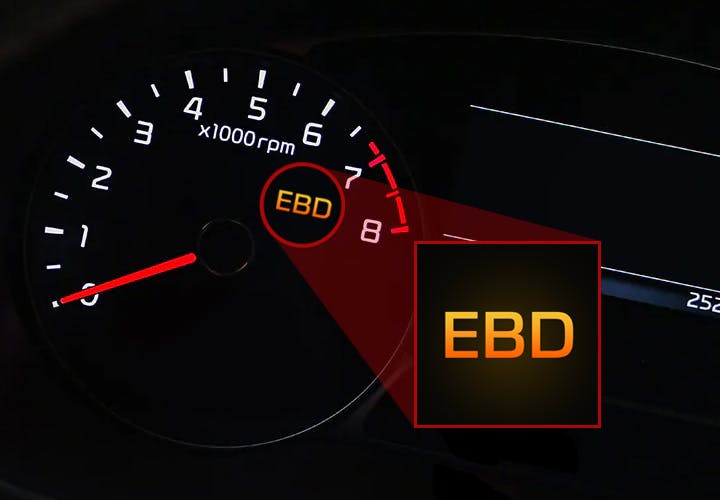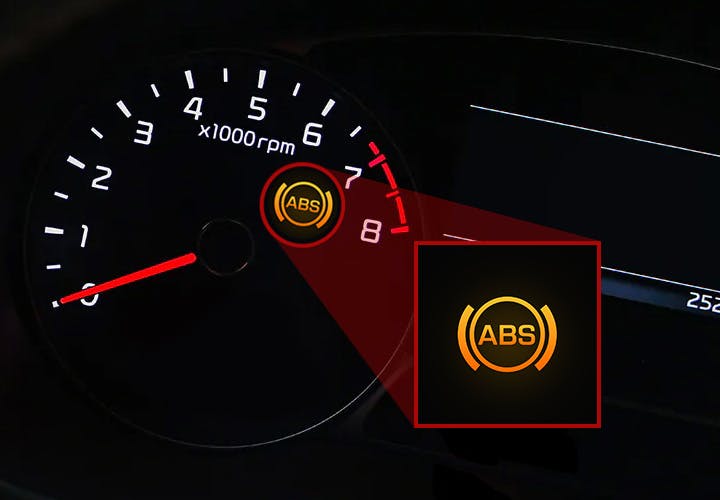EBD Warning Light: What does it indicate?

The EBD warning light indicates a malfunction of the EBD system (Electronic Brakeforce Distribution). If the warning light comes on while driving, the electronic brake force distribution system is probably not working.
EBD is an essential element in modern car technology, and its failure should not be ignored. In this article, we will shed some light on how the electronic brake force distribution system works and what it means when the EBD warning light is on.
Spis treści
What is EBD, and how does it work?
The EBD system changes the braking force applied to individual wheels depending on the speed of the vehicle's load but also on the condition of the road. This system prevents the wheels from locking by distributing the braking force between the front and rear axles according to the actual weight distribution of the car.
The electronic brake force distribution system can increase and decrease the effect of the braking force applied to each wheel to maximize braking power and shorten the car's stopping distance as much as possible while keeping the wheel rolling and the vehicle drivable.

Anti-lock braking system (ABS)
EBD usually distributes less brake pressure to the rear brakes to prevent them from locking up and causing skidding. The EBD system is always combined with the ABS system. The role of EBD as a subsystem of ABS is to ensure and control the effective use of wheel adhesion, thereby contributing to driving stability, shorter braking distances, and maximizing braking power.
The EBD warning light is on

During the engine start, this and other car dashboard symbols will appear for a short time, but if the system is working properly, it will go out immediately after starting.
An illuminated EBD warning light while driving probably signals a problem with the electronic brake force distribution system. The problem may be one of the following:
There was a malfunction of the EBD system itself
There was a malfunction of the sensor, respectively a malfunction the electronics
Whether there is a malfunction of the EBD system or just the sensor, these malfunctions cannot be solved by yourself, as in both cases, it is necessary to carry out vehicle diagnostics. The best thing you can do is to take your car to the repair shop immediately.

EBD: Electronic brake force distribution system
A malfunctioning EBD system should not be taken lightly. You may not be aware of it while driving, but thanks to it, the braking distance is shortened by almost half in certain cases.
Frequently asked questions about the EBD warning light
Question 1: Can I drive with the EBD warning light on?
Yes, driving with the EBD warning light is possible, but be extremely careful, especially in poor driving conditions. In addition, it is necessary to find the cause of the light coming on as soon as possible and solve the problem.
Driving with the EBD warning light on can mean worse vehicle handling and a significantly longer braking distance. So drive carefully, especially on slippery surfaces, especially avoid sudden braking.
Question 2: Can the EBD warning light come on even if there is no problem with the EBD system?
Yes, the warning light can come on even if there is no problem with the electronic brake force distribution system. The causes can be various, such as a fault in the electrical system or a problem with the sensor. In this case, performing a car diagnosis and eliminating the cause is necessary.
Conclusion
An illuminated EBD warning light should not be taken lightly, as electronic brake force distribution is one of the safety features of modern cars. This system helps shorten the braking distance and provides better stability and safety.